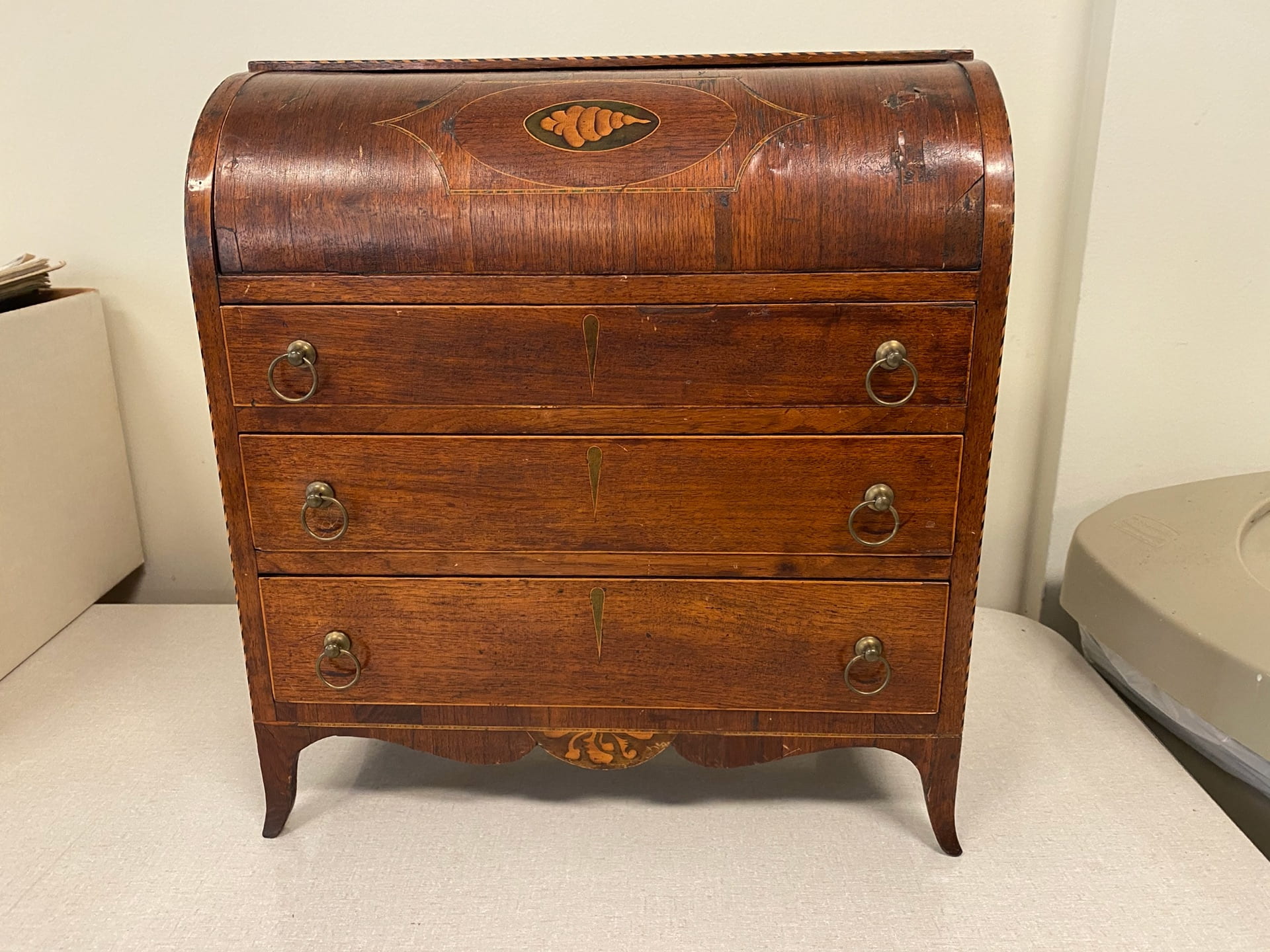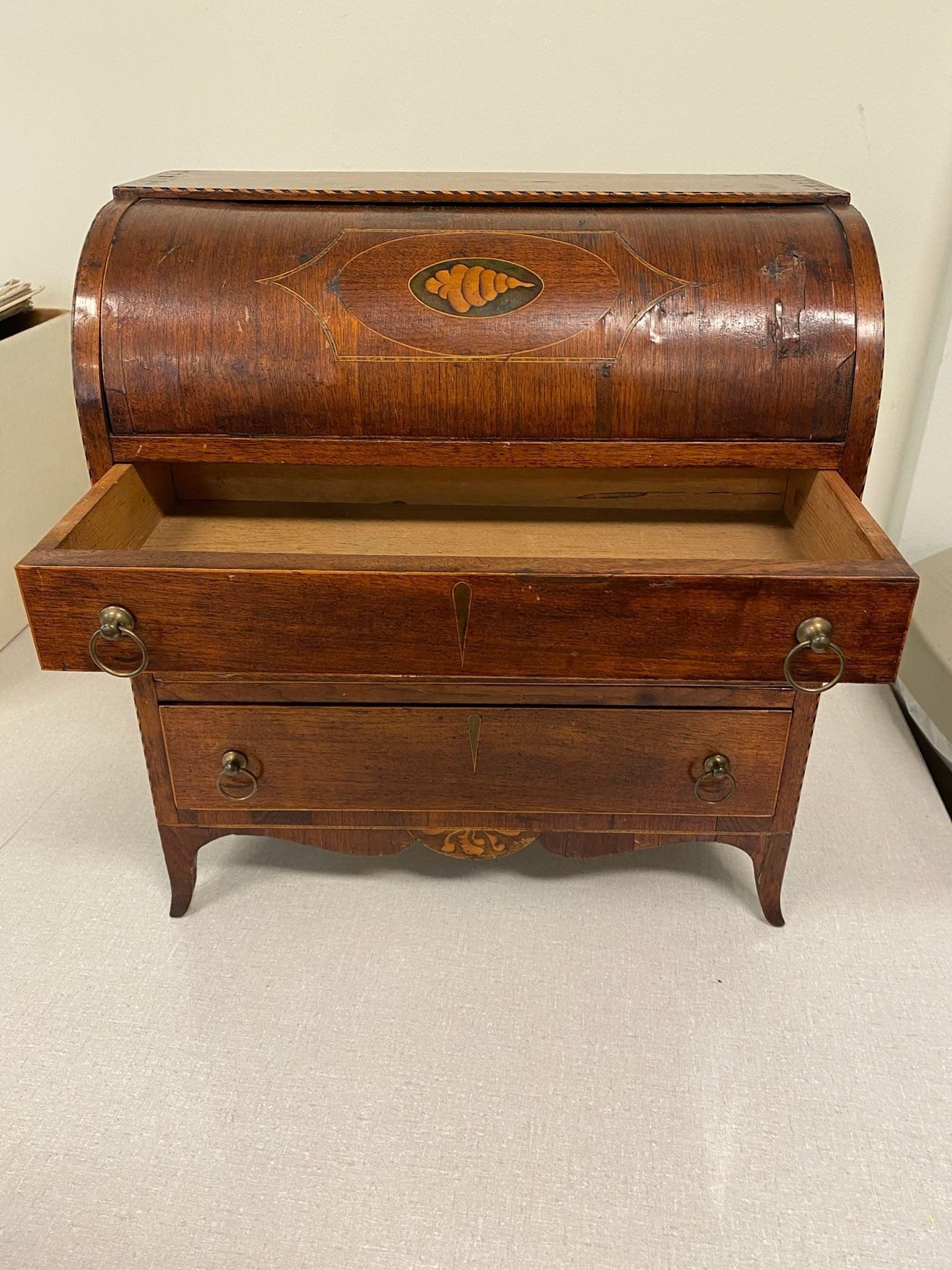Miniature Marvels: A Brief Look at a Miniature Desk in the Winterthur Museum
By Laura Ochoa Rincon, ’22
When observing a piece of miniature furniture, one might at first assume it to be an item marketed for children. While that assumption is not entirely incorrect, it is far too narrow. In reality, miniature furniture made in the eighteenth and nineteenth centuries served a range of uses. While some miniature furniture was made for children, many furniture makers specialized in miniature furniture for display use. It is not uncommon to find nineteenth-century examples of a full-sized piece of furniture coupled with its miniature equivalent. The wide array of uses for this type of furniture made miniatures popular with a wide audience.
Little is known about this miniature desk in Winterthur’s collection. Made in Baltimore between 1800-1810, it measures only 16.5″ tall, 15″ wide, and 8.25″ deep, presenting me with an exciting exercise in close looking. While museum records indicate that the desk is made from walnut, pine, and brass, closer inspection revealed that what appeared to be walnut was actually mahogany. Using magnification, I noted that the wood was diffuse porous and straight-grained, markedly different from the appearance of ring-porous walnut. The backboard and cabinets have been made from hard pine with an outer veneer.
The top of the desk features a cylindrical element veneered in mahogany. This curved movable section has been decorated with stringing atop the veneer. On each side of the curved element, two thin strips of mahogany veneer cover the curved boards. The top piece of mahogany is connected to the side boards with dovetail pins. Of the three drawers, two are the same length, width, and height while the top drawer is slightly smaller than the others. These drawers are connected with internal wooden grooves in the pine backboard. The brass hardware on the desk has become loose. In lieu of locks for the drawers, the maker of this desk used what seems to be faded green paint, creating a raindrop-like image where locks would be. This could indicate that the maker did not intend for valuable objects to be stored in this desk. It is also possible that miniature desks like these would be rather easy to steal, and the addition of individual locks may have seemed futile. Five glue blocks have been added to the bottom of the desk, although structurally these blocks are not necessary for a piece this small. The bottom perimeter of the desk is decorated with mosaic stringing, and a center decorative element has been added to the skirt.
Earlier iterations of this particular kind of object were difficult to find. I discovered through my research that the maker of this object was heavily influenced by Hepplewhite, as evidenced by his use of mahogany, design elements such as contrasting veneers and inlays, and soft French feet. First published in 1794, Hepplewhite’s Cabinet Maker and Upholsterer’s Guide became a inspiration for furniture makers of the early nineteenth century. Wildly popular during this period, Hepplewhite-inspired furniture was generally made from mahogany and was most often characterized by inlaid patterns and veneers, straight or tapered legs, and reeding. This desk may be a sample piece: during the eighteenth and nineteenth centuries, sample pieces gained popularity as portable, promotional examples of a cabinetmaker’s work.
Overall, this miniature desk is an excellent example of federal style furniture and displays many of the same hallmarks of taste as its full-sized counterparts. The maker of this desk drew inspiration from the same sources and used the same materials as they would have for a full-sized piece of furniture. Miniature objects such as these carry a certain sense of whimsy and novelty, whether or not they were actually used as objects for children. This desk is perhaps best interpreted as a sample piece of a particular craftsman’s work. The desk could have been made in this miniature size as a part of a set, but the lack of an identifiable full-sized counterpart makes that somewhat unlikely. I found this to be an interesting object that allowed me to study the construction of federal furniture without the difficulties associated with handling a full-sized object.
References:
Cross, Gary S. Kids’ Stuff: Toys and the Changing World of American Childhood. Cambridge, MA: Harvard University Press, 2001.
Lyons, Richard A., and Elizabeth G. Lyons. Making Miniature Furniture. Mineola, NY: Dover Publications, 1999.
Schiffer, Herbert F., and Peter Berwind Schiffer. Miniature Antique Furniture. Wynnewood, PA: Livingston Pub. Co, 1972.
Toller, Jane. Antique Miniature Furniture in Great Britain and America. London, UK: G. Bell, 1966.





This is so beautiful. I have a similar one with an I. sack paper label. The label is slightly damaged. I thought maybe it might be a reproduction used for a mate. I bought from a lady in S C. She inherited from her mother. Purchased Probably around 35 years ago. Don’t remember her name.
I was referring to the chest shown below the desk. Not to the desk but to the chest .